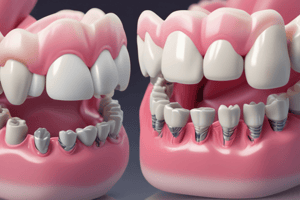Podcast
Questions and Answers
What are the objectives of classification of partially edentulous arches?
What are the objectives of classification of partially edentulous arches?
- Facilitate communication between dentists
- Allow visualization of the type of partially edentulous arch being discussed
- Serve as a guide to the type of design to be used
- All of the above (correct)
What is the defining feature of a 'TRUE RPD' according to the classification?
What is the defining feature of a 'TRUE RPD' according to the classification?
supported by both abutment teeth, mucosa, and underlying bone
In the Kennedy Classification System, Class I arch has bilateral edentulous areas located posterior to the remaining natural teeth.
In the Kennedy Classification System, Class I arch has bilateral edentulous areas located posterior to the remaining natural teeth.
True (A)
The _________ determines the classification in the Kennedy Classification System.
The _________ determines the classification in the Kennedy Classification System.
What is the function of a direct retainer in a partial denture?
What is the function of a direct retainer in a partial denture?
What is the function of an indirect retainer in a partial denture?
What is the function of an indirect retainer in a partial denture?
What are the components of a direct retainer in a partial denture?
What are the components of a direct retainer in a partial denture?
Prosthetic teeth are used on a denture to substitute for natural teeth.
Prosthetic teeth are used on a denture to substitute for natural teeth.
Proximal plates extend lingually so that the distance between the minor connector and the proximal plate is less than the ______________ width of the tooth.
Proximal plates extend lingually so that the distance between the minor connector and the proximal plate is less than the ______________ width of the tooth.
Flashcards are hidden until you start studying
Study Notes
Classification of Partially Edentulous Arches
- Objectives of classification: facilitates communication between dentists, allows visualization of the type of partially edentulous arch, permits differentiation between tooth-supported and tissue-supported partial dentures, and serves as a guide to the type of design to be used.
Components of RPD
-
Classifications of RPD based on supporting structures:
- Tooth-borne RPD: receives support from abutment teeth located anteriorly and posteriorly from the edentulous space.
- Tissue-borne RPD: receives or derives support entirely from the underlying mucosa and bone.
- Tooth-tissue borne RPD: supported by both abutment teeth, mucosa, and underlying bone.
-
Classification of RPD based on materials used:
- One-piece casting: consists of parts of the partial denture (except for the denture base and pontics) that are cast in one piece.
- One-piece casting (Skeleton Type): same as one-piece casting, except for the skeleton-like framework that is to be filled mostly by resin materials.
- Individually casted clasp assembly: only the clasp assembly is casted, and the rest is filled by resin materials.
- Wire clasp assembly: uses orthodontic wires for its clasps, and the rest is filled by resin materials.
- Retention plate partial denture: without any clasp assembly, uses the full coverage of the base as the means of support and retention of the denture.
Kennedy Classification System
-
Class I: bilateral edentulous areas located posterior to the remaining natural teeth.
-
Class II: unilateral edentulous area located posterior to the remaining natural teeth.
-
Class III: unilateral edentulous area with natural teeth both anterior and posterior to it.
-
Class IV: single, bilateral edentulous area located anterior to the remaining natural teeth.
-
Rules governing application of the Kennedy method:
- Rule 1: classification should follow rather than precede extractions that might alter the original classification.
- Rule 2: if the third molar is missing and not to be replaced, it is not considered in the classification.
- Rule 3: if a third molar is present and is to be used as an abutment, it is considered in the classification.
- Rule 4: if a second molar is missing and is not to be replaced, it is not considered in the classification.
- Rule 5: the most posterior edentulous area(s) always determines the classification.
- Rule 6: edentulous areas other than those determining the classification are referred to as modification spaces and are designated by their number.
- Rule 7: the extent of the modification is not considered, only the number of additional edentulous areas.
- Rule 8: there can be no modification areas in Class IV arches.
Components of RPD
- Major connector: connects the parts of one side of the dental arch to those of the other side.
- Minor connector: connects other components (i.e., direct retainer, indirect retainer, denture base, etc.) to the major connector.
- Direct retainer: a unit of a partial denture that provides retention against dislodging forces.
- Indirect retainer: a unit of a Class I or II partial denture that prevents or resists movement or rotation of the base(s) away from the residual ridge.
- Proximal plate: located on a guide plane on the distal surface of the tooth, extends lingually, and contacts the mucosa of the ridge crest for 2-3 mm.
- Rest: an occlusal, cingulum, or incisal surface that provides support and stability to the prosthesis.
- Denture base: the unit of the denture that rests on the foundation tissues and to which prosthetic teeth are attached.
Types of Mandibular Major Connector
- Palatal bar: a type of major connector.
- Palatal plate: a type of major connector.
- Palatal strap: a type of major connector.
- Lingual bar: a type of major connector.
- Lingual plate: a type of major connector.
Other Components
- Prosthetic teeth: artificial teeth used on a denture to substitute for natural teeth.
- Denture base retaining element: a type of minor connector that attaches the base to the major connector.
Studying That Suits You
Use AI to generate personalized quizzes and flashcards to suit your learning preferences.




